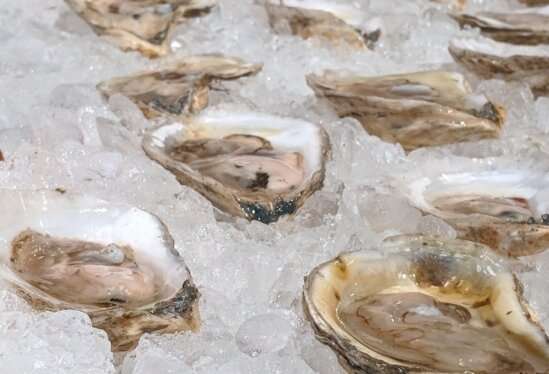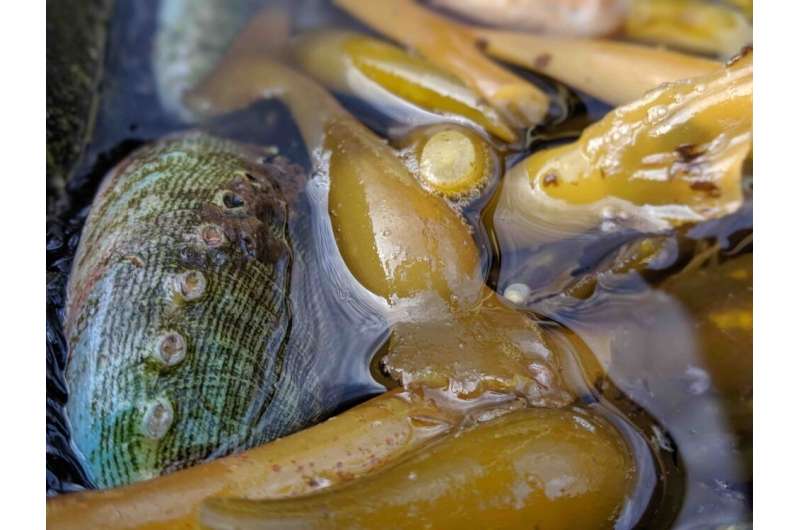Researchers collaborate on a strategy for sustainable aquaculture, the world's fastest growing food sector

As the population grows, and the global standard of living improves, humanity's appetite for seafood is increasing. In 2020 seafood consumption reached an all-time high, with an average of 20kg consumed annually by every person on the planet.
Up to now most of this was caught in the world's freshwaters and oceans. But things are changing, and today half of all seafood consumed comes from farmed sources, called aquaculture. The sector is expected to double by 2050 to supply the increasing global demand.
UC Santa Barbara Assistant Professor Halley E. Froehlich has contributed to an evaluation of the complex interactions between human, environmental and animal health parameters of this budding industry, a view scientists call the One Health framework. The study, published in the journal Nature Food, brings together a diverse team of scientists, economists, sociologists and policy specialists led by the Centre for Sustainable Aquaculture Futures—a joint initiative between the University of Exeter and the United Kingdom's Centre for Environment, Fisheries and Aquaculture Science.
"Aquaculture is now being more widely recognized as an important part of our global food system," said Froehlich, a faculty member in the departments of environmental studies and of ecology, evolution, and marine biology. "And it will continue to grow. So the question is, how do we plot that course in a more sustainable way?"
Aquaculture has played a major role in lifting millions of people out of poverty in many low and middle-income nations, but it faces a range of sustainability challenges. These include environmental degradation, overuse of antibiotics, release of disease agents and the requirement of wild-caught fish meal and fish oil to produce feed. Parts of the industry also engage in poor labor practices and gender inequality.
Negative societal impressions created by such examples mask aquaculture's potentially significant benefits. Farming cold-blooded animals is very efficient from a nutrient perspective. Many species, such as oysters, don't even require feeding. In addition, aquaculture can operate on a smaller footprint than many other forms of food production.

The new paper uses the One Health framework to lay out a set of metrics to include in national aquaculture strategies across the globe to improve sustainability as the industry expands. These include concepts like access to nutritious food and quality employment, the health of wild fish stocks and ecosystems and maintaining a small environmental footprint and resilience to climate change.
Communication, cooperation and coordination will be critical to the sustainable development of aquaculture as the sector grows. "If you don't have that knowledge transfer—for instance, from scientists to policy-makers or farmers to scientists—these types of framework structures won't go anywhere," Froehlich said.
With that in mind, the authors collaborated widely on this report. "The paper results from extensive interaction between a wide range of academic experts in aquaculture, health, environmental and social sciences, economists, industry stakeholders and policy groups," said senior co-author Charles Tyler from the University of Exeter.
The paper presents a strategy for developing aquiculture as well as the benchmarks to which we will measure its sustainability and success. "This is an important paper," said lead author, Grant Stentiford of the Centre for Environment, Fisheries and Aquaculture Science, "acknowledging that aquaculture is set to deliver most of our seafood by 2050, but also that sustainability must be designed-in at every level."
The One Health approach offers a tool for governments to consider when designing policies. "I hope it will become a blueprint for how government and industry interact on these issues in the future," Stentiford added. "Most importantly, it considers aquaculture's evolution from a subject studied by specialists to an important food sector—requiring now a much broader interaction with policy and society than arguably has occurred in the past."
Some of these principles are already being applied in the European Union and in Norway, according to Froehlich, who has begun shifting her focus toward the industry in the United States, especially California. She is currently in the middle of a Sea Grant project collecting the most comprehensive dataset of marine aquaculture information from across all coastal states in the U.S. This includes practices, policies, and the hidden interactions with fisheries that influence how aquaculture is conducted in each state.
"Aquaculture is everywhere and nowhere at the same time," Froehlich said. "People don't realize how integrated it is into so many facets of marine ecology, conservation biology, and fisheries."
More information: G. D. Stentiford et al, Sustainable aquaculture through the One Health lens, Nature Food (2020). DOI: 10.1038/s43016-020-0127-5
Journal information: Nature Food
Provided by University of California - Santa Barbara




















